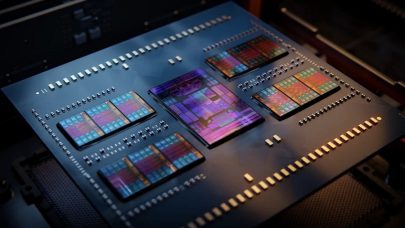
Meet TempoQuest, a Startup Bringing Weather Code Into the Accelerated Era
April 18, 2023
Weather and climate applications are some of the most important for high-performance computing, often serving as raisons d'être and flagship workloads for the Read more…

DGX Cloud Is Here: Nvidia’s AI Factory Services Start at $37,000
March 21, 2023
If you are a die-hard Nvidia loyalist, be ready to pay a fortune to use its AI factories in the cloud. Renting the GPU company's DGX Cloud, which is an all-inclusive AI supercomputer in the cloud, starts at $36,999 per instance for a month. The rental includes access to a cloud computer with eight Nvidia H100 or A100 GPUs and 640GB... Read more…

AMD’s Genoa CPUs Offer Up to 96 5nm Cores Across 12 Chiplets
November 10, 2022
AMD’s fourth-generation Epyc processor line has arrived, starting with the “general-purpose” architecture, called “Genoa,” the successor to third-gen Eypc Milan, which debuted in March of last year. At a launch event held today in San Francisco, AMD announced the general availability of the latest Epyc CPUs with up to 96 TSMC 5nm Zen 4 cores... Read more…

Microsoft Closes Confidential Computing Loop with AMD’s Milan Chip
September 22, 2022
Microsoft shared details on how it uses an AMD technology to secure artificial intelligence as it builds out a secure AI infrastructure in its Azure cloud service. Microsoft has a strong relationship with Nvidia, but is also working with AMD's Epyc chips (including the new 3D VCache series), MI Instinct accelerators, and also... Read more…

Rigetti Readies Ankaa and Lyra Quantum Processors for 2023, Says Quantum Advantage Close
September 16, 2022
Full-stack quantum computing startup Rigetti announced a number of new partnerships and strategic updates at its inaugural investor day meeting, held in-person Read more…

Microsoft Rolls Out Ampere Altra Arm CPUs in Azure
April 5, 2022
There was a time when “the cloud” ran on pretty vanilla x86 architecture, save for boutique firms like Nimbix (acquired by Atos last year) that pioneered the use of then-exotic hardware like GPUs and FPGAs and other Intel alternatives. If further evidence was needed of the... Read more…

Big Three Cloud Providers Halt New Business in Russia
March 10, 2022
Add Amazon Web Services to the growing list of companies (tech and otherwise) that are curtailing business with Russia in opposition to President Putin’s invasion of Ukraine. As reported in the New York Times and then by Amazon itself, Amazon Web Services is blocking new sign-ups from Russia and Belarus. Existing customers are not impacted. “We’ve suspended shipment of retail... Read more…

ISC Keynote: Why Quantum Computing Matters and the Race for Practical Uses
June 29, 2021
Matthias Troyer, who leads Microsoft’s quantum computing research, is on a mission, actually two missions. One is to develop practical applications for quantum computing. The other, also important, is to convince the HPC community that efforts to develop quantum computing – so frequently overhyped and off-putting... Read more…

- Click Here for More Headlines

Whitepaper
How Direct Liquid Cooling Improves Data Center Energy Efficiency
Data centers are experiencing increasing power consumption, space constraints and cooling demands due to the unprecedented computing power required by today’s chips and servers. HVAC cooling systems consume approximately 40% of a data center’s electricity. These systems traditionally use air conditioning, air handling and fans to cool the data center facility and IT equipment, ultimately resulting in high energy consumption and high carbon emissions. Data centers are moving to direct liquid cooled (DLC) systems to improve cooling efficiency thus lowering their PUE, operating expenses (OPEX) and carbon footprint.
This paper describes how CoolIT Systems (CoolIT) meets the need for improved energy efficiency in data centers and includes case studies that show how CoolIT’s DLC solutions improve energy efficiency, increase rack density, lower OPEX, and enable sustainability programs. CoolIT is the global market and innovation leader in scalable DLC solutions for the world’s most demanding computing environments. CoolIT’s end-to-end solutions meet the rising demand in cooling and the rising demand for energy efficiency.
Download Now
Sponsored by CoolIT
Whitepaper
Transforming Industrial and Automotive Manufacturing
Divergent Technologies developed a digital production system that can revolutionize automotive and industrial scale manufacturing. Divergent uses new manufacturing solutions and their Divergent Adaptive Production System (DAPS™) software to make vehicle manufacturing more efficient, less costly and decrease manufacturing waste by replacing existing design and production processes.
Divergent initially used on-premises workstations to run HPC simulations but faced challenges because their workstations could not achieve fast enough simulation times. Divergent also needed to free staff from managing the HPC system, CAE integration and IT update tasks.
Download Now
Sponsored by TotalCAE
Advanced Scale Career Development & Workforce Enhancement Center
Featured Advanced Scale Jobs:
HPCwire Resource Library
HPCwire Product Showcase
© 2024 HPCwire. All Rights Reserved. A Tabor Communications Publication
HPCwire is a registered trademark of Tabor Communications, Inc. Use of this site is governed by our Terms of Use and Privacy Policy.
Reproduction in whole or in part in any form or medium without express written permission of Tabor Communications, Inc. is prohibited.
























